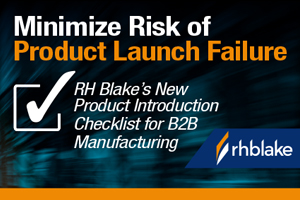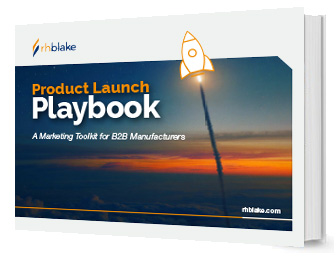New Product Introduction Checklist B2B Manufacturing

Written by Dan Konstantinovsky
Strategic Marketing, RH Blake
![]()
You’ve spent significant resources to develop a new B2B product or offering targeting the manufacturing ecosystem. Now it’s time to organize and strategize your new product launch. But before you can do that, let’s review the reasons for launching a new product in the first place.
Why Launch New Products
In general, B2B manufacturers launch new products in order to:
- Gain market share.
- Enter a new market or application.
- Generate new opportunities with existing customers.
- Stay top of mind with existing customers.
Product launches vary in scale — from new products to refined products designed for new applications. In certain instances, manufacturers use product launches to show customers that they are continually innovating and to remain top of mind until customers are ready to buy.
As you think about your short- and long-term objectives of your product launch, what convinces you that you’ll be successful? You have valid reasons to question your potential for success. According to McKinsey, more than 50% of B2B product launches fail to achieve business goals and objectives. But why are new product launches especially challenging in B2B manufacturing?
Why Product Launch Marketing Is Challenging
Launching a new product presents several distinct hurdles when trying to capture the attention of and engage with the target market in a meaningful way. There are several key reasons for this:
- Competition: Competitors, both direct and indirect, are vying for the attention of your target customer.
- Delayed pain points: Your target customer may not have the pain point your product addresses today. However, they may face it down the line. How do you create that initial awareness or perception to ensure that they think of you when their needs change?
- Lack of awareness around related capabilities: Your customer may be hard to engage if they don’t know or understand your capabilities.
- Lack of existing relationship with your firm: If your target customer doesn’t know you, they may not trust you enough to consider your new product or offering.
- Market viability: Your customer may not have had a chance to completely validate the unique value proposition and effectiveness of your offering.
- Lack of customer examples: These examples are needed to help demonstrate impact on business value and build trust in your customer.
- Disruption to their business: New products introduce perceived potential risks to your customer.
Once you grab your prospect’s attention, how do you engage them and influence them to think differently? Your product launch strategy must be effective and engaging in order to compel your target customer to take action.
Product Introduction Checklist: 5 Steps to Mitigate Risk of Product Launch Failure
Wouldn’t it be great to have a checklist or template to ensure that you don’t miss anything when launching your next B2B product? To help minimize your risk of failure, we developed this checklist based on our own experience and best practices. Use these five steps as a touchstone to guide your next B2B product launch:
New Product Introduction Checklist B2B Manufacturing
 Written by Dan Konstantinovsky
Written by Dan Konstantinovsky
Strategic Marketing, RH Blake
![]()
You’ve spent significant resources to develop a new B2B product or offering targeting the manufacturing ecosystem. Now it’s time to organize and strategize your new product launch. But before you can do that, let’s review the reasons for launching a new product in the first place.
Why Launch New Products
In general, B2B manufacturers launch new products in order to:
- Gain market share.
- Enter a new market or application.
- Generate new opportunities with existing customers.
- Stay top of mind with existing customers.
Product launches vary in scale — from new products to refined products designed for new applications. In certain instances, manufacturers use product launches to show customers that they are continually innovating and to remain top of mind until customers are ready to buy.
As you think about your short- and long-term objectives of your product launch, what convinces you that you’ll be successful? You have valid reasons to question your potential for success. According to McKinsey, more than 50% of B2B product launches fail to achieve business goals and objectives. But why are new product launches especially challenging in B2B manufacturing?
Why Product Launch Marketing Is Challenging
Launching a new product presents several distinct hurdles when trying to capture the attention of and engage with the target market in a meaningful way. There are several key reasons for this:
- Competition: Competitors, both direct and indirect, are vying for the attention of your target customer.
- Delayed pain points: Your target customer may not have the pain point your product addresses today. However, they may face it down the line. How do you create that initial awareness or perception to ensure that they think of you when their needs change?
- Lack of awareness around related capabilities: Your customer may be hard to engage if they don’t know or understand your capabilities.
- Lack of existing relationship with your firm: If your target customer doesn’t know you, they may not trust you enough to consider your new product or offering.
- Market viability: Your customer may not have had a chance to completely validate the unique value proposition and effectiveness of your offering.
- Lack of customer examples: These examples are needed to help demonstrate impact on business value and build trust in your customer.
- Disruption to their business: New products introduce perceived potential risks to your customer.
Once you grab your prospect’s attention, how do you engage them and influence them to think differently? Your product launch strategy must be effective and engaging in order to compel your target customer to take action.
Product Introduction Checklist: 5 Steps to Mitigate Risk of Product Launch Failure
Wouldn’t it be great to have a checklist or template to ensure that you don’t miss anything when launching your next B2B product? To help minimize your risk of failure, we developed this checklist based on our own experience and best practices. Use these five steps as a touchstone to guide your next B2B product launch:
Key Activities / Objectives
- Market Problems – discover / validate market with RH Blake Growth Roadmap™
- Voice of the Customer research
- Define and develop target customer personas – titles, functions, responsibilities, challenges, compelling events
- Understand and document the buying journey
- Identify content requirements for each persona and buying stage
- Competitive landscape – identify alternative offerings and assess their strengths and weaknesses
- Assess unique selling proposition and define value statements for each target audience
- List and compare applications, assess individual segment information and buying funnel needs
- Confirm business case opportunity and establish budget
- Help determine distribution strategy and channels
- Anticipate Sales education needs
- Identify complementary sales opportunities
- Establish launch overall success metrics (sales, marketing KPI, trials, geographic/territory)
- Confirm launch update meetings
Deliverables
- Business Case
- RH Blake Growth Roadmap™
- Marketing and Communication Plan
- Messaging Framework
- Align with Engineering and Manufacturing on schedule and availability of prototype(s), samples
- Align with Sales on performance objectives, target accounts, launch timing, commissions
- Align with Product Management to identify coherent positioning within existing and future product portfolio
- Monitor development/production in case timing adjustments are needed
Content Deliverables
- Delivery Instructions
- Installation and Start-up Procedures
- Ordering Process
- Pricing Guidance Document
- User Manuals/Installation
- Product Demo
Key Activities / Objectives
- Determine logistics, personnel requirements for launch activities
- Anticipate and coordinate sales training program (webinar, in person)
- Anticipate and coordinate channel partner training program (webinar, in person)
- Alert service department and anticipate information needs, imagery requirements, advance planning for target-customer testimonials
Key Activities / Objectives
- Develop/confirm name, identity and branding
- Develop strategies for generating awareness and leads
- Secure trade show or other event space / date(s) as needed
- Collaborate with stakeholders to define specific plans for selling new offering to customers (e.g. Account Based Marketing)
- Consider Search Engine Optimization and paid digital advertising
- Create marketing assets for new offering
- Consider advance release to selected media,
- Plan and secure launch event at trade show or other venue including pre- and post-show communication
- Create support materials
- Establish social plan including channels and timing
- Consider sales promotions
Content Deliverables
- Article
- Brochure
- Customer Letter/Email Introducing Offering
- Customer References
- Customer ROI Projection
- Channel Partner Presentation
- External Sales Presentation
- Infographic
- Internal Sales Presentation
- Lead Generator (e.g., Assessment, ROI Tool, White Paper, etc.)
- Photos (before/during/after)
- Press Release and Distribution
- Proposal Template
- Sales FAQ
- Sales Tips and Tactics
- Support Processes
- Technical FAQ
- Training Plan and Technical Support
- Vanity (Arrange for unique URL(s), 800 number(s) or other specific vanity communication channels)
- Video (before/during/after; training; education)
- Website Content and Landing Page
- White Paper
- Digital
- Search Engine Marketing (e.g., AdWords, LinkedIn)
- Search Engine Optimization
- Social Media – Communicate Offering/content
- Nurturing Campaigns
- Events
- Media Event
- Event/Trade Show Alignment
- Internal Webinar Launch
- Channel Partner/Distribution Guidance
- Content for Channel Partners/Distributors/Influencers
- Create Channel Partner Tools; Digital and Additional Assets
Key Activities / Objectives
- Customer satisfaction evaluation and measurement
- Updates to content, web, training, etc.
- Review and consider ongoing Sales promotion/incentives
- Assess product launch and overall product success metrics
B2B Product Introduction Checklists and Resources
As a manufacturer or a firm targeting manufacturers, it’s important to maximize your investment in developing new products and applications. Following our New Product Introduction Checklist for B2B Manufacturing will help you minimize your risk of product launch failure, counting you among the 50% of manufacturers who launch their products successfully. It will also help you stay top of mind and drive superior business growth results.
To support your success, we’re happy to share some other resources focused on B2B manufacturing product launches:
- HubSpot – How to Launch a Product, According to HubSpot’s Product Marketers
- Product Plan – Product Launch Checklists: From the Oscars to a Software Product Release, They’re Necessary
- Product Marketing Alliance – Your new product launch checklist
- Manufacturing Business Technology – Product Development: Key Steps to Take and Avoid
- Lucidchart – What to Include in a New Product Launch Checklist [+Example to Get You Started]
- AltexSoft – How to Launch a Successful Product: Timing, Roles, and Product Launch Checklist
- RH Blake – Launching a B2B Industrial Product? Consider These Five Best Practices
- RH Blake – How to Create the Perfect B2B Launch Presentation – Tips for Manufacturing Marketers
- RH Blake – Plan for B2B Manufacturing Product Launch Success
- RH Blake – Presented at FabTech: 5 Steps to Ensuring Your Next B2B Manufacturing Product Launch Is Successful


